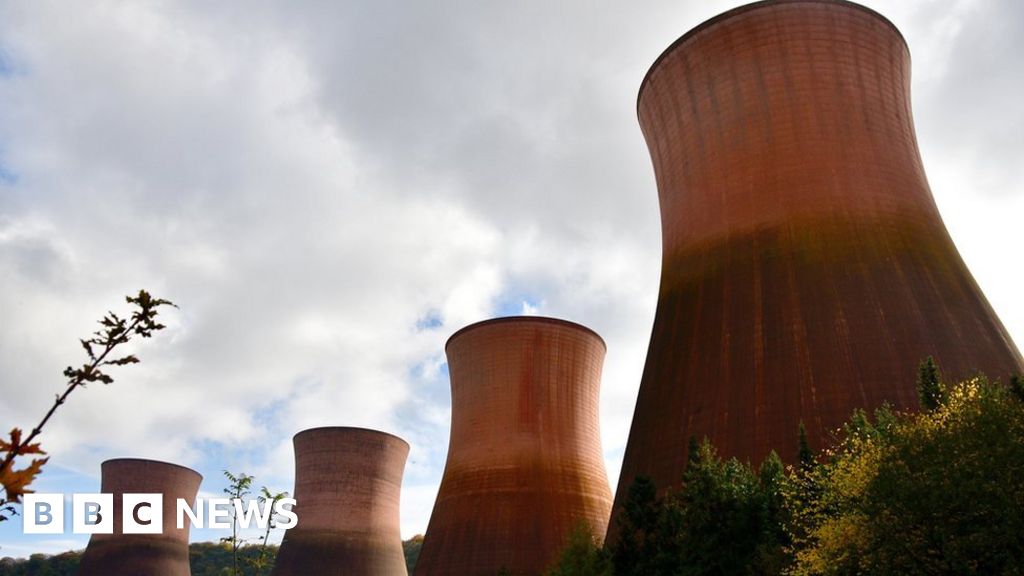An early morning in March
History
Construction of the first power station at Ironbridge began in 1929 and when completed contained four 50MW turbines manufactured by British Thomson Houston. This became know as ‘Ironbridge A’ when construction of a second, much larger station began in 1963. Due to faults with the machinery in the new station, Ironbridge ‘A’ continued to produce electricity well after the ‘B’ station was completed, finally shutting down in 1978 and demolished shortly after, despite attempts to preserve the complex as an industrial museum.
Ironbridge ‘B’ was one of the many large stations commissioned by the CEGB in the 1960s at a time when electricity demand was dramatically increasing and was to be equipped with two 500MW units. Due to delays in construction, the new power station didn’t reach full capacity until the second unit went online in February 1970. The building is a near identical copy of its slightly earlier ‘parent’ station at Eggborough, although half the size and built in a much more challenging landscape. A considerable amount of care was taken in the design process to ensure the new buildings enhanced its fine natural surroundings, most notably of which is the cooling towers to which a red pigment was added to match the colour of the local soil. The power station opted out of the Large Combustion Plant Directive in 2008, forcing it to close by the end of 2015, or after 20,000 hours of generation. In 2012 the station was modified to run on 100% biomass, resulting in the replacement of most of the pulverising fuel mills and reduced the total capacity by around 260MW. In February 2014 a fire seriously damaged unit 1 generator, caused by one of the turbine blades failing, instantly stopping the turbine running 3,000rpm. Thankfully no one was injured but it was decided the damage would not be repaired and the station closed on 20th November 2015. Despite much local support, English Heritage have refused to have the unique cooling towers listed and demolition is now underway to remove all traces of one of the finest industrial views in Britain.
Ironbridge 'A' after completion of the first phase in 1932
The explore
I first visited Ironbridge in March this year but couldn’t do much besides walking around the cooling towers due to demolition workers doing stuff around the main building. It was June when I was finally able to have another go and this time I was able to arrive while it was still dark, allowing a good look around before any workers might turn up. Access turned out to be surprisingly simple, especially considering the amount of effort which had been taken to weld or brick up most of the external entrances. I was relived to find the turbine hall so far untouched by the demolition workers and it was great to see the whole turbine hall filled with golden light at sunrise entering in from walls of glass. It’s a great shame that the building isn’t in the same condition as Eggborough with its PF mills, control room and all units intact as in my opinion it would have been the perfect large power station for preservation. Its setting is stunning and with very strong links to the industrial revolution, the buildings is of a much more manageable size then many of the 500MW stations and its in easy reach of many people. I spent the whole day inside and although I wasted many hours asleep in the control room I managed to see almost everything I wanted to though I had to rush around the admin block as the light was fading though a lot of stripping has already commenced in there.
Turbine hall
The boiler house and chimney seen from the roof of the turbine hall
Fire damaged unit 1 with its alternator removed
Melted gauges demonstrating the heat of the fire
Looking towards unit 2
Unit 2
Pipes on the intermediate and high-pressure cylinders on unit 2
Unit 2 from the gantry
One of the water feed pumps on the ground level
Unit 1 condensers, partly dismantled and showing fire damage to the plinths
Control room
Sadly the original control desks were removed in the 90s and replaced by computerized systems but the room is still quite nice
The original control room with the modern control room situated behind the glass panels to the left
The modern control room



 :
: